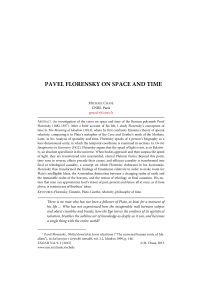Pavel Florensky on space and time
Автор: Chase Michael
Журнал: Schole. Философское антиковедение и классическая традиция @classics-nsu-schole
Рубрика: Человеческое измерение времени
Статья в выпуске: 1 т.9, 2015 года.
Бесплатный доступ
An investigation of the views on space and time of the Russian polymath Pavel Florensky (1882-1937). After a brief account of his life, I study Florensky’s conception of time in The Meaning of Idealism (1914), where he first confronts Einstein’s theory of special relativity, comparing it to Plato’s metaphor of the Cave and Goethe’s myth of the Mothers. Later, in his Analysis of spatiality and time, Florensky speaks of a person’s biography as a four-dimensional unity, in which the temporal coordinate is examined in sections. In On the Imaginaries in Geometry (1922), Florensky argues that the speed of light is not, as in Relativity, an absolute speed limit in the universe. When bodies approach and then surpass the speed of light, they are transformed into unextended, eternal Platonic forms. Beyond this point, time runs in reverse, effects precede their causes, and efficient causality is transformed into final or teleological causality, a concept on which Florensky elaborates in his Iconostasis. Florensky thus transformed the findings of Einsteinian relativity in order to make room for Plato’s intelligible Ideas, the Aristotelian distinction between a changing realm of earth and the immutable realm of the heavens, and the notion of teleology or final causation. His notion that man can approximate God’s vision of past, present and future all at once, as if from above, is reminiscent of Boethius’ ideas.
Florensky, einstein, plato, goethe, relativity, philosophy of time
Короткий адрес: https://sciup.org/147103398
IDR: 147103398
Список литературы Pavel Florensky on space and time
- 1974. La colonna e il fondamento della verità. Saggio di teodicea ortodoxa in dodici lettere, a cura di E. Zolla, trad. it. di P. Modesto, Milano: Rusconi. Nuova edizione, riveduta e corretta, a cura di N. Valentini, Cinisello Balsamo: San Paolo 2010.
- 1995. Pavel Florenskij, Lo spazio e il tempo nell’arte, a cura di Nicoletta Misler, Milano: Adelphi, rist. 2001.
- 1999. Il cuore cherubico. Scritti teologici e mistici, a cura di N. Valentini e L. Zák, trad. it. di R. Zugan, Casale Monferrato: Piemme.
- 2000. «Non dimenticatemi». Le lettere dal gulag del grande matematico, filosofo e sacerdote russo, a cura di N. Valentini e L. Zák, trad. it. di G. Guaita e L. Charitonov, Milano: Mondadori, rist. 2006.
- 2003. Pavel Aleksandrovič Florenskij, Ai miei figli. Memorie di giorni passati, a cura di N. Valentini e L. Zák, trad. it. di C. Zonghetti, Milano: Mondadori, rist. 2009.
- 2007. Pavel A. Florenskij, Il simbolo e la forma. Scritti di filosofia della scienza, a cura di Natalino Valentini e Alexandre Gorelov, traduzione dal russo di Claudia Zonghetti, Torino: Bollato Boringhieri (Nuova Cultura 168).
- 2008. Pavel Aleksandrovič Florenskij. Stratificazioni, Scritti sull’arte e la tecnica, a cura di Nicoletta Misler, traduzione di Valentina Parisi, Regio Emilia: Diabasis (Lo spazio e il tempo, 5).
- 2008b. Pavel A. Florenskij, Iconostasi. Saggio sull’icona, Traduzione e cura Giuseppina Giuliano, Milano: Edizioni Medua (Hermes, 15).
- 2012. Florenskij Pavel A., Il significato dell’idealisimo. La metafisica del genere e dello sguardo, a cura di Natalino Valentini, traduzione di Rossella Zugan, Milano: SE (Testi e Documenti 217)
- Chase, Michael (2012) “Can we escape mortality ? Some Neoplatonic and Islamic views on time and eternity”, in ΕΣΧΑΤΟΣ (Eschatos). Filosofiya istorii v kontekste idei predela. Issue 2. Odessa, Ukraine: FLP Fridman: 10-40.
- Chase, Michael (2012b) “Teleology and final causation in Aristotle and in contemporary science”, Dialogue: Revue Canadienne de Philosophie 50, 511-536.
- Chase, Michael (2014) “Time and Eternity from Plotinus and Boethius to Einstein,” ΣΧΟΛΗ (Schole). Ancient Philosophy and the Classical Tradition 8.1, 67-110.
- Dalrymple Henderson, L. (1983) The fourth dimension and non-Euclidean geometry in modern art. Princeton: Princeton University Press.
- Gleiser, Marcelo (1997) The dancing universe. From creation to the Big Bang. Hanover, New Hampshire: Dartmouth College Press, 2nd ed. 2005.
- Graham, Loren, & Jean-Michel Cantor (2009) Naming infinity. A true story of religious mysticism and mathematical creativity. Cambridge: Belknap Press of Harvard University Press.
- Hadot, Pierre (2006) The Veil of Isis, An essay on the history of the idea of nature, translated by Michael Chase, Cambridge (Mass.): Belknap Press of Harvard University Press.
- Zák, Lubomir (2001) “Il mistero del tempo come «quarta dimensione» in Pavel A. Florenskij”, Dialegesthai. Rivista telematica di filosofia , anno 3, http://mondodomani.org/dialegesthai/lz02.htm, accessed Oct. 6, 2014.
- Zák, Lubomir (2009) “L’unità e la molteplicità dello spazio e del tempo secondo la teoria della discontinuità di Pavel Aleksandrovič Florenskij,” in M. Alfano & R. Buccheri, eds., Tempo della Fisica e Tempo dell’Uomo: Relatività e Razionalità, Trapani -Ferrara: I.I.S. “Leonardo da Vinci” -Akousmata: orizzonti dell’ascolto: 191-226.


